Checking Wikipedia I just learned that a Shogun was a title given to Japanese military dukes from the twelfth to the late nineteenth century. During this era there was much turmoil on the island, it was often the military caste struggling for power. The inherit meaning of the word and title Shogun is “the One who conquers the Barbarians”. A statement and clear entitlement for a boat, I thought: Welcome to my walkthrough of the Shogun 43 sailing yacht.
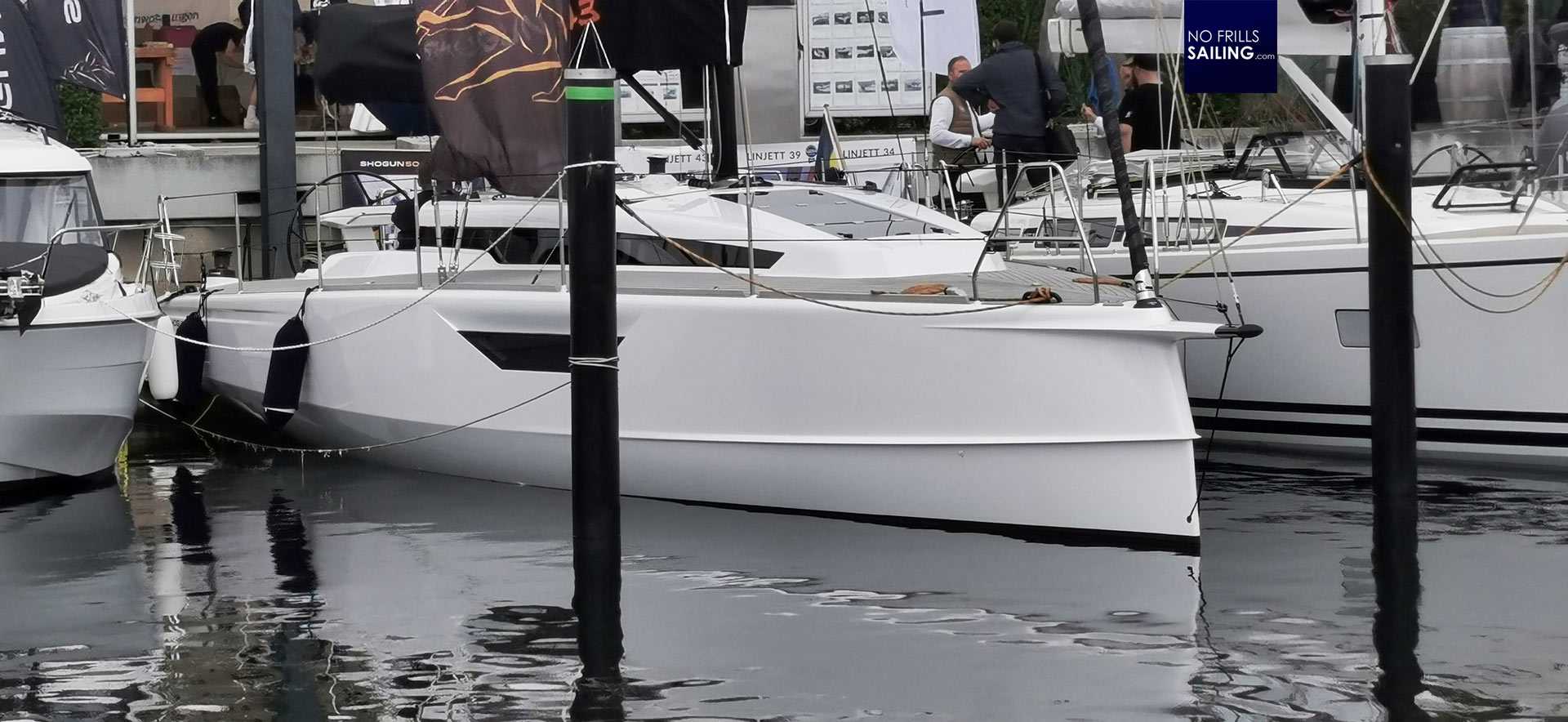
The Shogun 43 is the smaller sister of the 50 feet flagship. These boats stirred up the yachting world upon arrival because they are kind of extreme and contradictory in so many aspects. It´s very exciting to see that a shipyard is willing to come up with a product that is so special, so unique, so un-expected, to say so, in the best sense of the word.
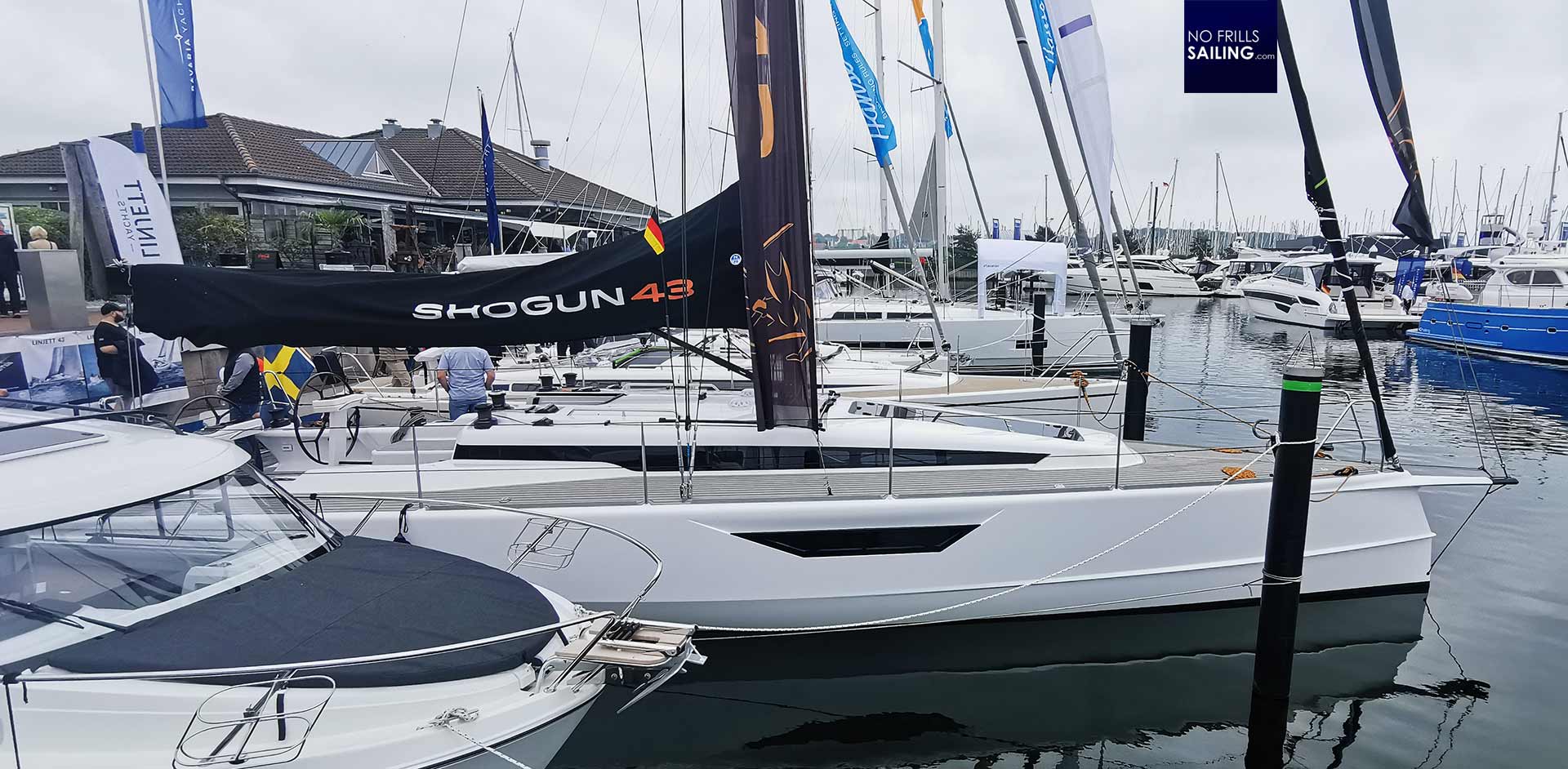
The Shogun is a visual statement. The first glance at her lines make clear that this is a boat that wants to stand out of the crowd. She does not want to be pretty, adorable or “nice”. No blending in or going wit the flow. The Shogun is a head-turner. Aggressive lines, angles, shapes – and she not only just looks fast, she indeed is fast! I am welcomed aboard by Oscar Södergren, the very designer and naval architect who is responsible for this yacht – what a better guide through the boat could there be?
A pretty un-Swedish performance yacht
Södergren tells me a lot about the designing process and the thoughts behind the Shogun sailboats. These are made by Linjett Yachts, a very renowned Swedish boat builder near Stockholm, a brand that stands for high quality cruising yachts. Scandinavian style: Sophisticated, classic, conservative (in the best sense of the word). He says, that Shogun is refreshingly un-Swedish. So what does that mean?

First of all, you can clearly see with your own eyes that this boat is something completely different. Her shapes, the lines, the sheer – she clearly has some “Asian” design influences, just like if a Volvo or Saab car and a Gundam robot had a floating baby. If you wouldn´t know and there wasn´t the Swedish flag at her stern, you could never guess her origins.
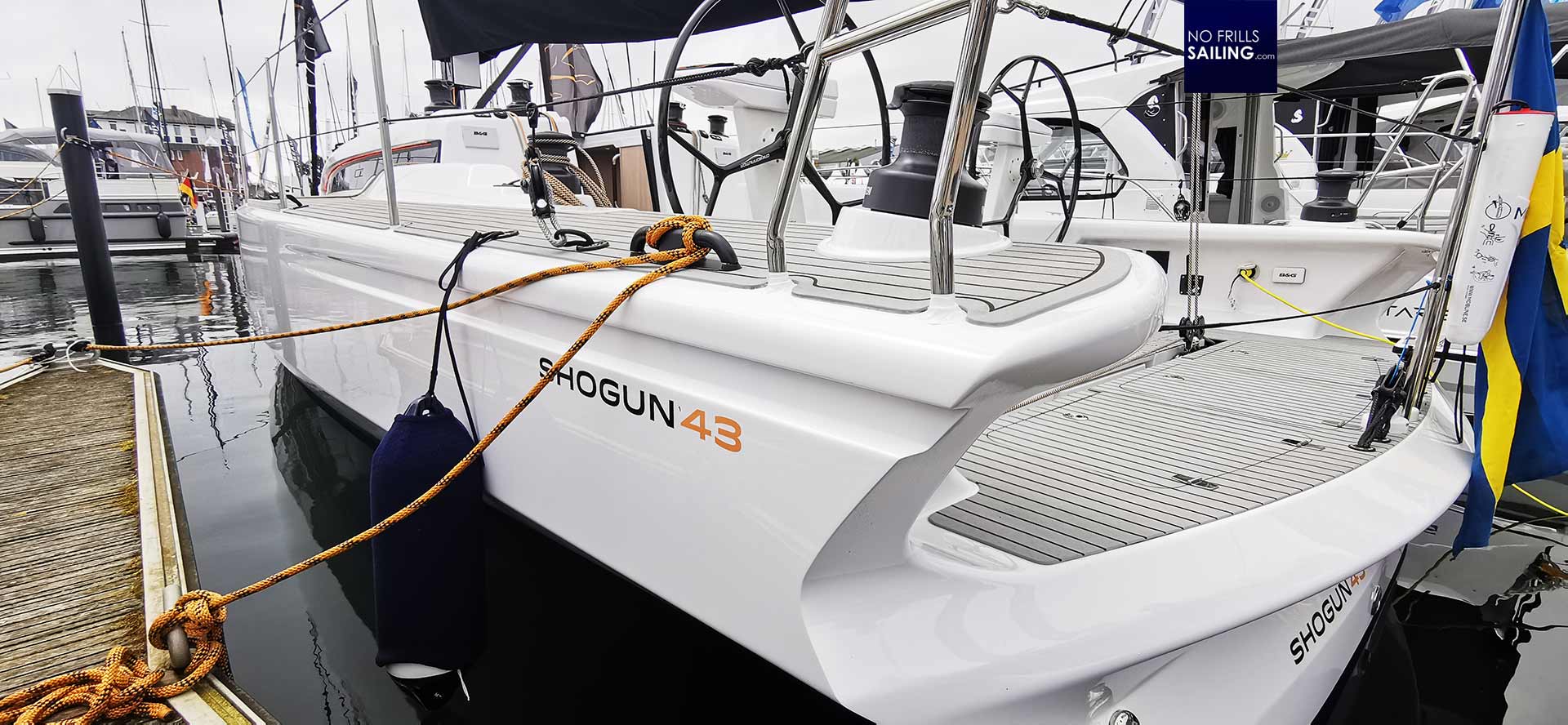
The stern part of the yacht, open design, no transom, no bathing platform, is clearly stating that this yacht is made for speed and exceptional performance. It almost looks like a standstill photograph of a starship buzzing by, ripped off shapes, very fluent. Mediating speed. I think Södergren made a wonderful job in finding a shape that looks as if it is speeding – even when moored dead still on a pontoon.

The Shogun 43 has an overall length of 13.1 meters (12.3 meters waterline length) with a fixed bow sprit. With a max beam of 3.7 meters (waterline beam 2.9 meters) she definitely has an interesting – not as radical – length/beam ratio. She indeed is a planning hull, but a surprisingly “narrow” one too: A balancing act between early planning and nice upwind beating capabilities.
Tempting shapes
Those interesting shapes are made possible by the special methods of production. Linjett Yachts has a cooperation for the Shogun-lineup with Vaxholm Composites. This is a company specializing in Carbon manufacturing and handling. Sitiated not too far away from Linjett, these guys are responsible for deck, hull and other structurally important parts of the yacht.

Utilizing Carbon fibers ensures not only the exceptionally lightweight and rigid properties of the Shogun yachts, but also comes up for the possibility of creating such interesting shapes. The hull-deck-connection for example on the Shogun 43 are not, as one would expect, made as with literally any other boat by having a hull, a “bathtub” if you will, with a deck coming on top of it. As for Shogun, the hull is laminated all the way up including the sidewalk deck – the “top cap” is just the coachroof cabin structure.

This and some other specialties allows for much more freedom in design. You can see it by looking closely at so many details, some distinguished hidden, some more prominent. Like the wonderfully shaped integrated bowsprit for Gennaker and Code-sails, which is part of the very hull. Form and function following the properties of the special material.

The Shogun 43 is full of little nice details and it takes quite some time to grasp the full scope of her. Just like the little “chine-line” that is apparent running from the inverted stem all the way back – functioning as a kind of wave and spray deflector but making also a nice visual to further define the aggressive outward appearance of this boat.
Light footed sailing – powerful performance
She is a very fun boat to sail, says Oscar, telling me that he regularly takes out one of the Shogun 43 in Mallorca. Maneuvering like a small dinghy in the marina, handling and navigating this yacht is no problem at all, he assures me. Outside, raising the sails, she also behaves like a small jollyboat: Nimble, light footed and fast. “She does not need more that eight knots true to enter planning mode”, he says – his eyes on fire, smiling knowingly.

At her controls, I can see that most of the trimming tools are run electrically. All the winches are push-button, but also the mainsheet traveler for fine tuning, the outhaul and vang are adjusted to fit the current situation by simple pushing a button.

I loved how the mainsheet lines are run down below, making the cockpit truly free of any rope salad and allow for sheer, clean coamings. As with everything, here they are again, those little details you will only recognize when truly looking into understanding this boat. This yacht will satisfy the highest demands of any aspiring skipper or owner.
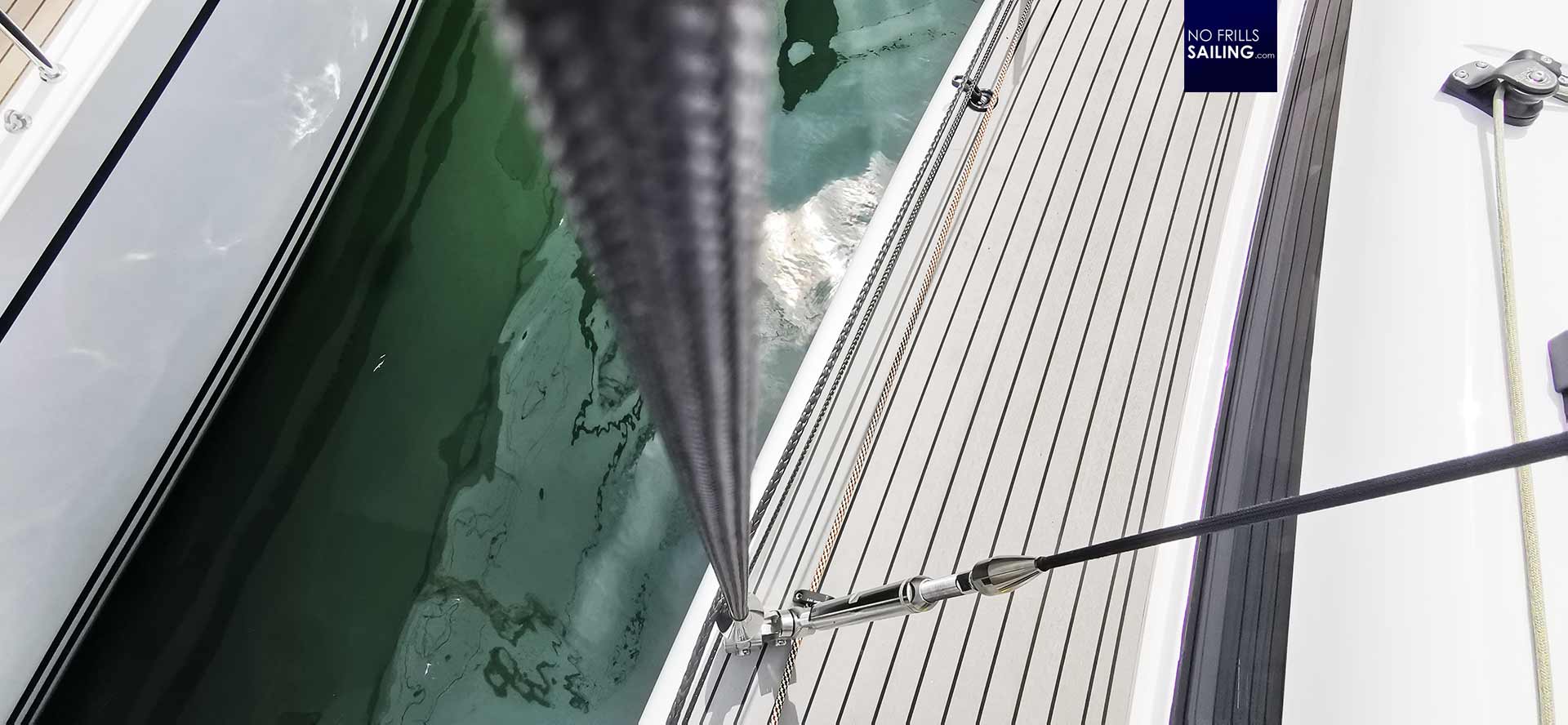
The standing rigging, for example, is not standard steel wires. For the Shogun they even skipped the usually welcomed upgrade to rod rigging. On this boat there are wonderfully manufactured Carbon shrouds giving stability and rigidity to the keel-steeped mast. It takes me full five minutes to appreciate the manufacturing details of those shrouds.

The Shogun 43 comes with a total of eight (!) winches. Where most production cruisers will have just two of them to operate a mainsail and one self-tacking jib, offering an upgrade to four winches for having a Genoa, Code-lightwind sails and asymmetric Spinnakers, this yacht gives the skipper the opportunity to run his boat over no less than eight winches. Which makes her a very versatile yacht too.

Depending on the use case, all sails may be operated from the coach roof. Entering a crewed race, every position of the trimming party may be positioned nicely in the cockpit so that every one can operate a dedicated winch without bothering the other crew members. Eight winches and an impressive set of cleats clearly states the performance character of this yacht.
43 feet for owners
In this, Oscar explains, she may be used to winning regattas against dedicated lightweight racing boats but at the same time offers a full cruising capable setup for the owner to enjoy a nice vacation. We enter down the companionway into the salon and I understand: This is not the usual weight-saving kind of Spartan clean, reduced interior. It´s an awesome, lush, welcoming “at home” atmosphere you clearly would not expect on a yacht made to be as light as possible!
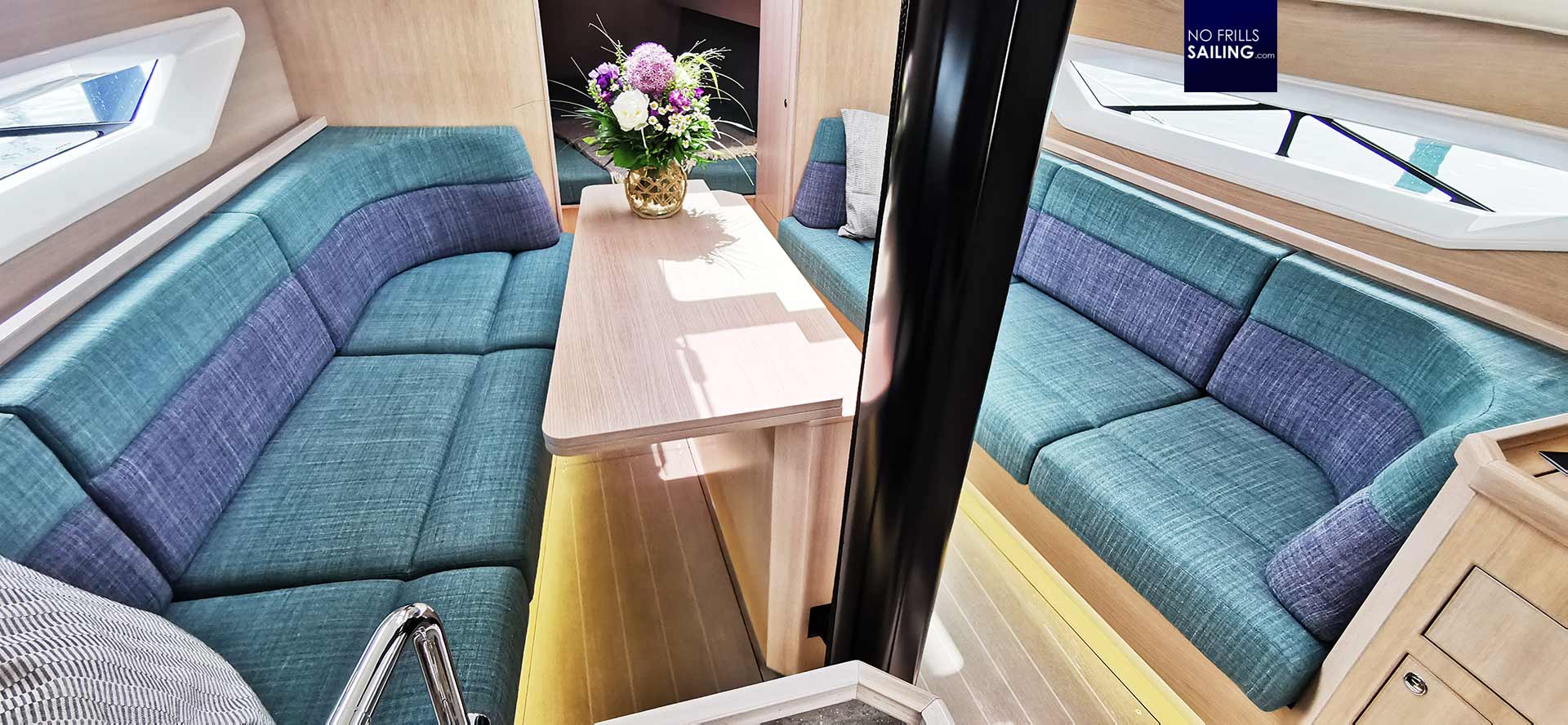
The two facing main sofas in the salon are absolute fire! Just look at the thickness of the upholstery! Taking a seat here is so cozy, I rarely experience such a richness of comfort in th every cushions. There is barely any plastic (or Carbon) to be seen, everything is covered with wood-veneered facings. You feel like entering a full-blown luxury cruiser.

As a dedicated NO FRILLS SAILING.com-reader you may know that I am kind of obsessed with roofing panels since my restauration efforts of the Kings Cruiser 33. And boy how much I love the wonderfully crafted panels of the Shogun 43! Just look at the quilted thick (padded as well!) quality of those panels. I instantly sent this picture to my shipyard in Waren, currently building the Omega 42, asking if they could make something like this for my boat too …
Loads of natural light
A big thing in boats is light. Long gone are the times when you had the feeling of going down into a grave dark basement. Customers demand light suffused boats, a lofty, light feeling. Thanks to modern materials, high-bonding chemicals (like glue) and tapered, hard materials for windows designers can incorporate large transparent areas into their designs. Even larger windows near the waterline aren´t a safety issue anymore.

The Shogun 43 is a nice example for light conception. Standing in the saloon (or reclining onto those awesome settees!) you feel as if you were in a wintergarden. So many windows making the salon flooded with natural light. There are large hull windows, windows in the coachroof and most impressive – skylights!
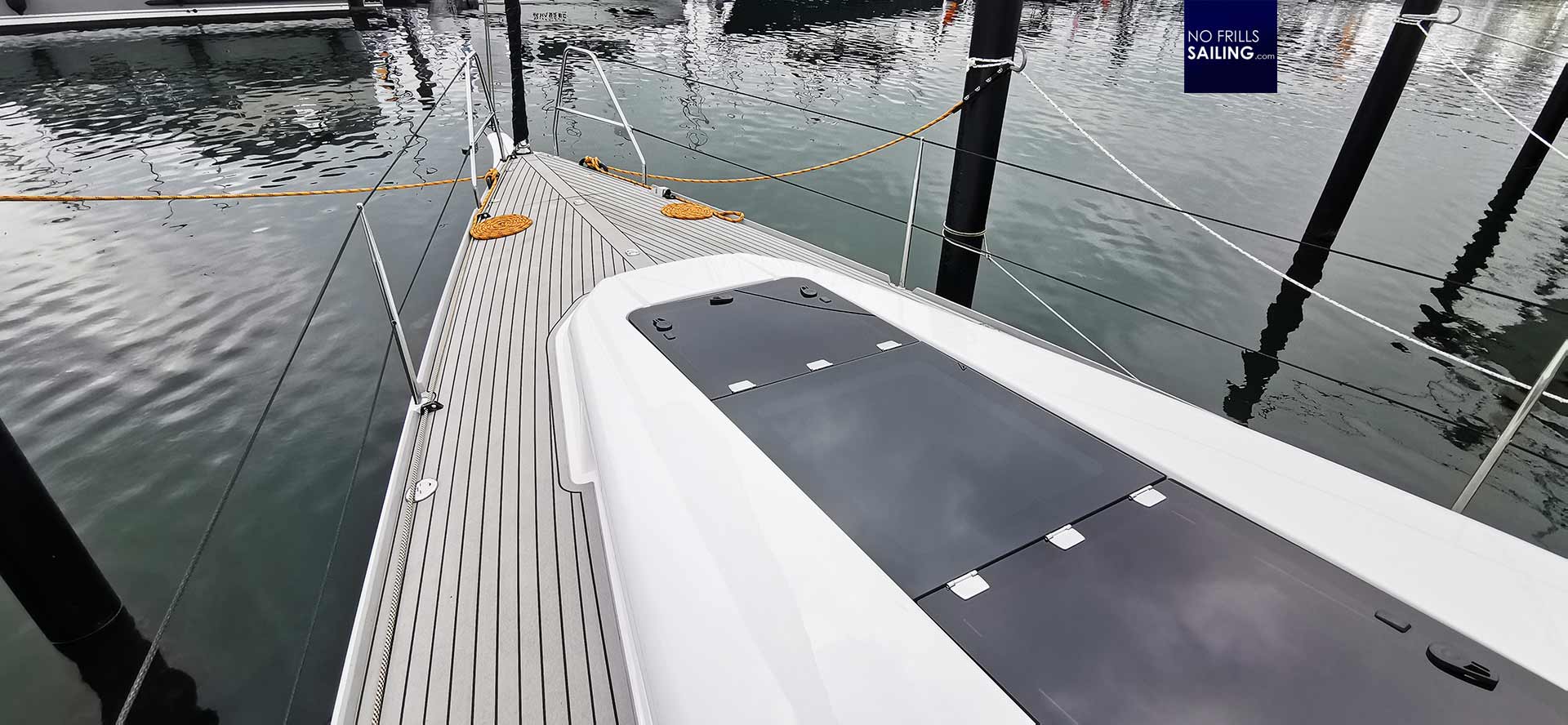
Looking from outside, the whole roofing area in front of the mast is one continuous thick stripe of skylight windows. Seen from here, that´s a bold visual statement and adds to the aggressive looks of the Shogun 43. Crafted absolutely nicely, mounted flush, integrated into the smooth lines of the whole coachroof design. The same area seen from below explains that the true intention wasn´t of purely design-nature.

Two large opening hatches will add to the ventilation of fresh air inside the boat, this “stripe” of skylights is truly adding so much to the atmosphere down below. The whole boat is light suffused. I can imagine just how great the looks must be when the boat is out sailing, you may enjoy some hours off watch, laying in the settee and looking out to the mast top, full blown sails, a colorful Gennaker up … awesome!
Cruising? No problem!
But she´s not just pretty, she can cook too! The Shogun 43 comes with a full-fledged galley. The L-shaped galley has everything you need even for a long summer cruising trip: Two burner stove with oven, a large top loading fridge and big enough partitioned sink. The worktop is a bit small to prepare a meal when some elaborate veggie chopping is to be done, but the large salon table may be used for this alternatively.
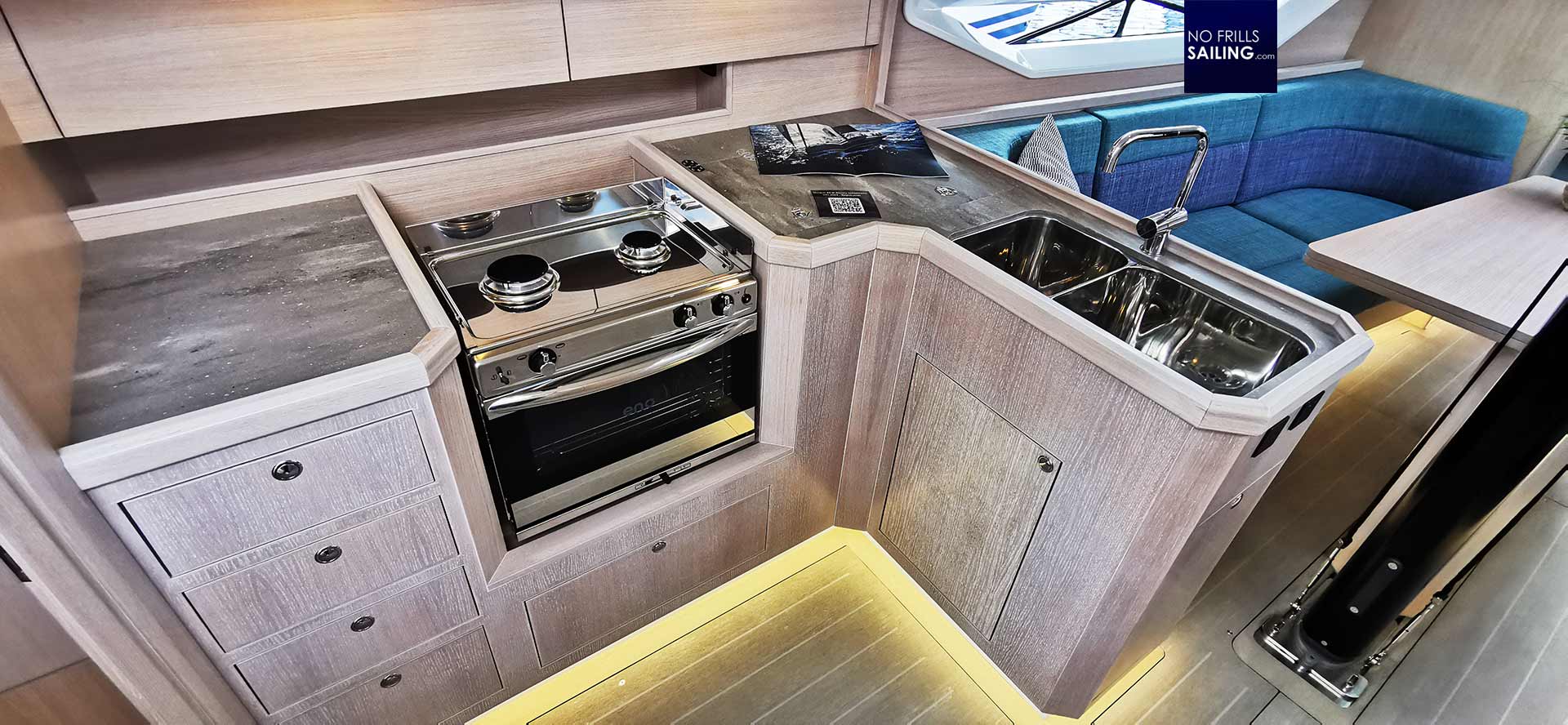
I smiled a bit when I took a look at the small nav station. It instantly reminded me of the interior concept we are currently realizing in my Omega 42: Of course does a boat need some dedicated place for the main switch panel, the VHF and some stowage for all the navigational material, logbook or binoculars. The Shogun 43 comes with such a small, reduced chart table as well.

The general layout of her down below is a non-classic 3 cabin layout, I shall say. Upon entering down the companionway there´s the L-shaped galley to port side (where it belongs), the bathroom to starboard side (later more on that) and the classic salon with just two symmetrically settees facing each other. This boat offers six berths (plus two when the salon settees are counted as well).

Again, a bit un-Swedish, as Oscar says: Just one single bathroom. Not unlike to the “radical” concept of the First 36 the designer decided to have only one toilet aboard this reasonably big sized boat. This yacht will be sailed by a couple, a single handed ambitious owner who races her or at best occasionally with a small crew. No need to shove in more toilets.

I remember Kristian Hajnsek from Seascape, when asked why the new First 36 as a 3-cabin boat just features one single small cramped bathroom, answering a bit provocatively: “Do you want to sail or do you want to shit?” Well, maybe a bit drastic, but I can see their point here: Mostly the boats are run by a minimum crew, a couple or even single handed. No real need to feature (and maintain) many more toilets, really …
2 and a half cabins
Coming back to the comfort side of this performance boat: I mentioned that she is a two-and-a-half cabin yacht. There are two aft cabins, reasonably sized, which have classic doors and thus can ensure complete privacy for their occupants. No obstacle head-wise like in so many cruisers by the bench-lockers, these cabins are really big and offer nice volume. There are no hull windows, which is a bit of a downside – on the other hand, usually, you are here to sleep, not to watch the nice scenery outside …

The fore cabin is a different thing. Oscar Södergren decided not to fit doors in here, so this “cabin” isn´t a cabin in the true sense of the word. Maybe the yard will make a door upon request, but the idea is that the forepeak anyway is the most uncomfortable place to try to find a good sleep when underway. And because this boat is sailed by few people at best, the two aft cabins will do just perfectly.

When at anchor or at the pontoon – and alone – the owner or owner-couple don´t need a door anyways when sleeping in the bow, so why bothering fitting one in the first place? That´s what I was thinking too when I decided to have no doors at all in my Omega 42 (except for the bathroom of course). In total, she is classic – but with some very nice twists and unexpected turns here and there. I like it.
A true Shogun …
Not having sailed with her, it is of course just an interpretation of watching videos of the Shogun 43 sailing or looking and interpreting her bare data. Weighing just over 6 tons she carries a lead bulb (on a full Carbon keel fin!) of 2.6 tons, which is a whopping 42 per cent ballast ratio! That´s one stiff powerful boat! Carrying 114 square meters of upwind sails area in standard configuration (main plus self-tacking Jib) it truly means: Power!

For comparison, the wonderful X-Yachts Xp 44 with similar measurements (13.8 by 4.7 meters) displaces 8.6 tons (with 3.8 tons ballast / 41 per cent ballast/weight-ration) – she carries 106 square meters with Genoa and Mainsail. It would be interesting to see both matchracing, especially upwind. Downwind I suppose the Shogun will be planning and flying away, considering her wider hull and planning capabilities.

I thank Oscar for the exclusive tour aboard this Barbarian conqueror. The Shogun 43 is clearly a very special yacht for very special people. Exceptionally well made by absolutely skilled craftsmen, supported by a shipyard that stands for the highest Scandinavian boatbuilding approach, the Shogun 43 will find her dedicated owners for sure. And maybe set off to show it to those “Barbarians” on the racing circuits of the big regattas.
You might as well like these related articles too:
Talking about Scandinavian boating culture with Jeppesen, Sehested and Rassy
The interior concept of my Omega 42
Swift and fast: Arcona Yachts of Sweden
